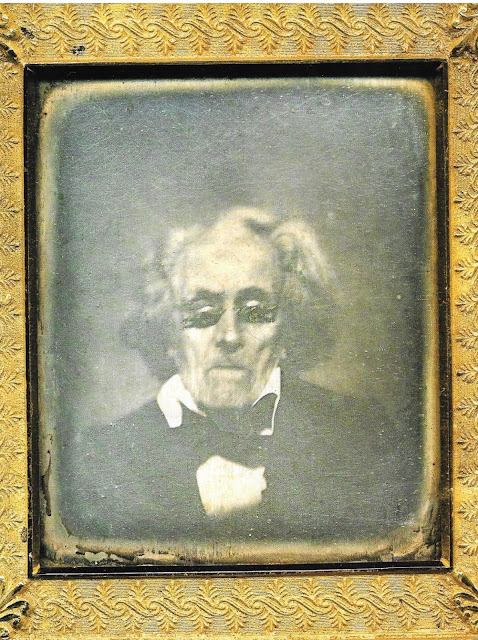Pierre-Etienne du Ponceau or Peter Stephen du Ponceau after he anglicized it arrived in America at the age of 17 in the Company of the Baron von Steuben. Von Steuben had hired him, as a translator and aide-de-camp, in France. Some people have speculated that du Ponceau and von Steuben, a gay man, had a personal relationship as well as a professional one.
Du Ponceau was given the brevet rank of captain in the Continental Army. He translated von Steuben’s orders to the army from German to English at Valley Forge. Du Ponceau resigned from the army in 1779 when it was believed he had consumption (Tuberculosis).
He recovered from his illness, that was almost certainly not Tuberculosis, by 1781. He became the undersecretary for foreign affairs to Robert R. Livingston when he became Secretary for Foreign Affairs under the Articles of Confederation. The small staff also included Lewis Morris as undersecretary for domestic affairs. At first all Livingston could offer the men was a room in his house, food and the chance to meet the upper crust of society when they visited him. Although Congress was not thrilled with du Ponceau’s choice as undersecretary eventually Livingston was able to secure an $800 salary for du Ponceau. Du Ponceau would have been responsible for translating incoming and outgoing mail from and to various European courts. He continued in this role until 1783 when the war ended.[i]
After the war du Ponceau settled in Philadelphia where he became a lawyer. He also continued to study languages, which was where his true genius lay. He had translated von Steuben’s Regulations for the Order and Discipline of the Troops of the United Statesin 1779. After the war a steady stream of books of his own followed, including English Phonology, Making our National Literature Independent, and Grammar of the Language of the Leni Lenape or Delaware Indians. He published several other books on the languages of the Indigenous American. Du Ponceau became one of the first westerns to realize that the Chinese written language was made of words and was not ideographic.
Du Ponceau was elected to the most prestigious organizations of the time. The American Philosophical Society in 1791, becoming president of the Society in 1828. In 1818 he was elected to the American Antiquarian Society and in 1820 the American Academy of Arts and Sciences.
In his personal life du Ponceau married twice and had three children, all of whom he outlived. In fact, du Ponceau continued to be a vibrant and useful man well after much of the Revolutionary generation had retired or died.
In 1805 James Madison asked du Ponceau to describe for him the history of British aggression toward neutral parties during times of war.[ii] Du Ponceau, in fact, quite liked Madison. In 1808 he passed on word from Robert R. Livingston that the Clintonians in New York would vote for Madison for president.[iii] In 1810 du Ponceau sent the first copy of his translation of Bynkershock’s Questions Juris Publicis out of “respect and veneration of your character and my attachment to your person.[iv]
Du Ponceau would also be a frequent correspondent of Thomas Jefferson as well. They corresponded on matters of politics but also on matters of natural history and languages. On July 12, 1820 du Ponceau sent a list of numerals to Jefferson comparing the language of the “Nottoway, Onondago and Mohawk.”[v] On the next day du Ponceau passed on a lexicon of several words in many indigenous languages.[vi]
Around 1840 du Ponceau became one of the few veterans of the Revolutionary War to sit for a daguerreotype. Du Ponceau died in 1844 at the age of 84. He is buried in Philadelphia.
[i]Dangerfield, George Chancellor Robert R. Livingston of New York 1746-1813 Harcourt, Brace and Company, New York 1960 p 145-146
[ii] “To James Madison from Peter S. Du Ponceau, 8 July 1805,” Founders Online, National Archives, https://founders.archives.gov/documents/Madison/02-10-02-0029. [Original source: The Papers of James Madison, Secretary of State Series, vol. 10, 1 July 1805–31 December 1805, ed. Mary A. Hackett, J. C. A. Stagg, Mary Parke Johnson, Anne Mandeville Colony, and Katherine E. Harbury. Charlottesville: University of Virginia Press, 2014, pp. 36–44.]
[iii] “To James Madison from Peter Stephen Duponceau, 26 November 1808,” Founders Online, National Archives, https://founders.archives.gov/documents/Madison/99-01-02-3757.
[iv] “To James Madison from Peter Stephen DuPonceau, 15 November 1810,” Founders Online, National Archives, https://founders.archives.gov/documents/Madison/03-03-02-0017. [Original source: The Papers of James Madison, Presidential Series, vol. 3, 3 November 1810–4 November 1811, ed. J. C. A. Stagg, Jeanne Kerr Cross, and Susan Holbrook Perdue. Charlottesville: University Press of Virginia, 1996, pp. 14–15.]
[v] “Peter Stephen Du Ponceau: List of Indian Numerals., ca. 12 July 1820, 12 July 1820,” Founders Online, National Archives, https://founders.archives.gov/documents/Jefferson/98-01-02-1382.
[vi] “Peter S. Du Ponceau: Comparative Vocabulary of Nottoway and Iroquois Idioms, ca. 13 July 1820, 13 July 1820,” Founders Online, National Archives, https://founders.archives.gov/documents/Jefferson/98-01-02-1388.

